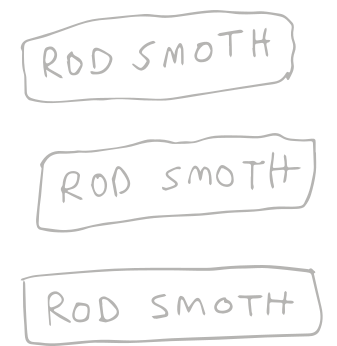Handles
Instagram: @rodsmoth
Facebook: @rodsmothmusic
Spotify: Rod Smoth
Apple Music: Rod Smoth
Bandcamp: Rod Smoth
Logos
Rod Smoth logo - dark
download (right click to download)
Rod Smoth logo - light
download (right click to download)
Photos
(right click to download)
photos by R. Cole Furlow
Bio
The song “Almost See” by Rod Smoth begins like this: “It's like painting a portrait/Except every passing stroke disappears the moment after it is drawn/But you believe it’s still there.” As far as aesthetics go, this is a pretty strong mission statement. The song moves at a lazy drawl, quiet but intense, with an air of menace at its fringes. At the chorus, the song seems to slow down, becoming heavier, more deliberate, as the harmonies come in: “And at the end you know if you really stare/You can almost see it's a masterpiece.”
Rod Smoth is the project of Mississippi singer and guitarist Reed Smith. Raised in a family of southern gospel singers, Smith first picked up the guitar when he was eight years old. He began playing music with his family and graduated to heavier music in his teens, playing with various bands across the diverse and fertile Jackson, Mississippi music scene. Smith attended college in the Mississippi Delta, and eventually found himself with an internship in Nashville, sleeping on a friend’s couch. It was here that he picked up an acoustic guitar, fingerpicking and singing quietly so as not to bother his roommates. These limitations gave Smith the perfect outlet for his musical vision. By combining the eerie quiet of folk music with the darkness of stoner rock, Rod Smoth was born.
Rod Smoth’s self-titled debut was recorded in producer Cole Furlow’s (Low Variety, Dead Gaze) home studio above a bar in downtown Jackson, Mississippi. Jesse Coppenbarger (Colour Revolt, El Obo) played bass and sang background vocals, while Logan Owensby sang and played drums and Jacob Lifsey handled synths and programming. The album was tracked live, with bass, drums, guitars, and the lead vocal recorded together in a tailgating tent constructed in Furlow’s studio.
“We had to build a live room to keep the sound under control,” says Smith. “We wound up with this big tent that people used for tailgating football games, and we just threw it up in the studio and draped blankets over it. The whole thing was kind of spooky.” The bulk of the songs were recorded over three live sessions in three days, with Smith and Furlow tinkering on the songs for several months afterwards.





